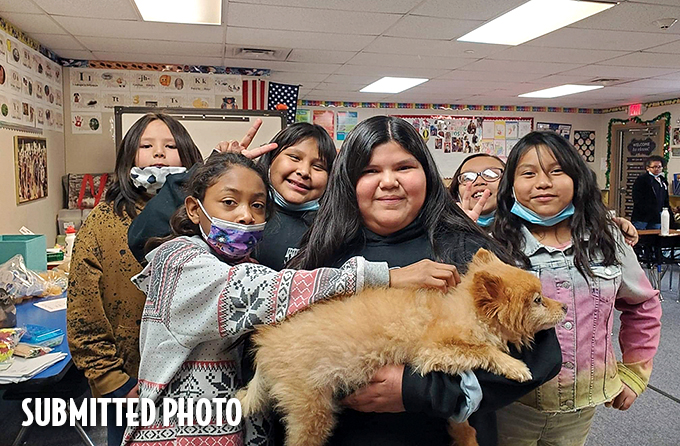Celebrating Women's History Month: Alvarez dedicates teaching to making a difference for Native youth

Alex Alvarez (center) with CTEA staff and founding board members.
By ROSELYNN YAZZIE
Sho-Ban News
FORT HALL — Alex Alvarez is teaching her second year at Chief Tahgee Elementary Academy (CTEA).
She became an educator because she saw a great need for Native teachers for Indian Youth and she wanted to do her best to become a kind, caring, and compassionate teacher. She also wanted to make language learning fun and help the children understand the beauty that resides in the language.
Her first year at CTEA she taught English Language Arts and then unexpectedly had to step in as the Shoshone teacher part way through the year for third through eighth grades.
This year she’s continued teaching Shoshone for third through eighth grade and says it has been a dream job.
“I’m a second language learner and I am working toward fluency, but with the help of the other Shoshone teachers: Bailey Dann, Jordan Broncho, RJ Kutch and Merlin Study, I am on my way to becoming fluent,” she said.
Alvarez feels becoming a teacher has brought her full circle.
“I started as a founding board member at Chief Tahgee and worked with some of my greatest mentors and inspirations, the late Maxine Edmo-Racehorse, the late Merceline Boyer, as well as Nancy Eschief- Murillo, Belma Colter, and Velda Racehorse. Those ladies were immensely dedicated to seeing Chief Tahgee become a reality and I am honored to share that legacy with them. One of the biggest struggles I saw as a board member was finding teachers that were interested in learning and teaching the Shoshone language, which ultimately led to me to making the decision to go back to school to become an elementary teacher,” she said.
Alvarez graduated from United Tribes Technical College in Bismarck, North Dakota.
When it comes to teaching the language she said, “Our language is connected to everything that we are as Indigenous people, and as long as our youth have our language and our culture they can thrive in whatever they wish to become, and also continue to keep our language alive.”
It’s important to her for the children to see a teacher who represented them. The majority of the teachers she had growing up were non-Indian.
“Now the kids can see that they have a teacher who wears elk teeth, and beaded medallions, and rocks the work of other Native artists like War Medicine Empire, Lauren GoodDay, Kira Murillo and local beadwork artists too! Like Shanna Dawes, Kylee White, the Late Camille George, Lennis “Tuff Guy” Denny, Austin Tracy, Delicia Dann and Clinton Houtz to name a few. I want them to be inspired, and to be proud of who we are.”

Alvarez’s class with Wahni.
Currently CTEA is only teaching Shoshone, but it’s still a vision to eventually have a Bannock language instructor at the school one day.
She encourages language learning to all.
“If you feel it in your heart to keep our language alive, I want to encourage readers to consider becoming a teacher. The school is still in its infancy as far as language is concerned, and there is so much potential for growth. Many of the successful immersion programs have been teaching since the 70s. Our school has only been opened for less than 10 years,” she said.
Furthermore, she said, “I’ve seen the power of language and how it can empower our youth to strengthen their identity as Sho-Ban youth. It’s important to note in order for our language to survive we must speak our language outside of ceremony as well. It must be spoken as easily as we speak English. It must be used in every day conversation, and to ask simple questions and communication. The school isn’t going to save our language alone, our youth and families must continue speaking Shoshone outside of the classroom, and must help strengthen it by becoming invested in our community and working to better it.”
Alvarez’s favorite part of teaching is the children.
“It’s so exciting and fascinating to see and hear our kids learning the Shoshone language and culture. In my classroom, I’m working to intertwine culture, as well as cultural arts like beading and sewing. A goal for our school is to plan field trip days, so that the kids can learn where to find edible and medicinal plants on the reservation and to have vast knowledge of who we are as Indigenous people; what did we eat? What did we wear? Where are our people now? What is sovereignty? What is a treaty? What is our treaty? Those are the kinds of knowledge I want our kids to leave with, and feel empowered by,” she explained.
Teaching also gives her the opportunity to show her love for the Indian children.
“So many of our children are dealing with things that are out of their control. School is not always #1 in their minds, and some spend time thinking about where their next meal will come from, where will they be day to day, and are worrying about problems that they cannot fix just yet. My hope is that when they come to my classroom, that they can just focus on being a language learner, and have a structured routine day to day to give them some balance, and allow them to just be kids with their classmates. They will walk in and out of my classroom knowing that they are loved by their teacher, and that they believe that they can achieve anything they set their minds too.”
She recently shared with her students a story about two eagle brothers who were raised by chickens, but one discovered who he was, and learned to soar with eagles. She told the kids, “You can’t soar with eagles if your too busy hanging with chickens.”
Eagles can fly the highest, even higher than planes, and that’s what she hopes they all chose to do — to soar and reach their highest dreams.
Her hope for her students is that like the eagle brother story, they will know who they are, and become the greatest version of themselves, empowered by culture and language, that they will continue to speak the language with their families and friends.
Alvarez said there have been proven statistics showing that youth who are affected by Adverse Childhood Trauma can still succeed as long as they have at least one adult who believes in them. Therefore, she tells her kids she believes in them, and she believes in their hopes and dreams. She shares with them the path to success isn’t just a linear map from point A to point B, there are setbacks that can change dreams and goals in life.
She shares with them experience of how when she was in elementary school she thought she was going to become a veterinarian and then for many years she thought she was going to become a lawyer. Then she worked as a journalist for the Sho-Ban News for a few years before finally deciding she wanted to become a teacher.
Her last hope is when the kids leave her classroom they will know their teacher loves and cares for them and wants them to succeed. She wants them to know at one time the language was nearly taken away, but they are the first generation that can freely speak and learn the language. “By the time I’m a grandma, we are going to see our children speaking the language again,” said Alvarez.
Her advice for people wanting to learn the language or take part in culture and traditions is by starting right now. She said if you’re looking for a sign - this is your sign to start!
“I say that lovingly and whole heartedly. The first step is to start coming to the events hosted in our community and to read the Sho- Ban News. The Sho-Ban news covers a wide variety of things happening in our community, and shares upcoming events. As we move away from the pandemic, one of our goals at CTEA is to host family fun nights, and Language Camps to further the language with our kids and eventually host a language and culture nights for our students and their families.”
The Language, Culture and Preservation Department hosts weekly language classes for both Shoshone and Bannock languages. They also have a highly dedicated team that hope to see the language learned and thrive again in our community.
Alvarez also has a big heart for animals and has been sharing that appreciation with the students.
One of her classroom pets is a red eared slider turtle she got last year and has been at home during the winter, due to the cold. She will bring him back to the school this spring. His name is “duugi” or “Dembi Yagwasa”. The kids loved to help me feed him and to watch him swim in his tank.

Wahni with a handmade crown made by students.
Then there’s the beloved Wahni, who started her journey at the school back in the summer of 2021.
“After the passing of my Gaga naup Leona Houtz and Togo naup Cliff Houtz, my mom and I were struggling to care for Wahni at home. My grandma Leona had been Wahni’s primary caregiver for years and each day it was like we took Wahni to daycare. She would go to grandma’s in the morning and come home at night,” she explained.
As an elder dog they needed a new routine for her care. During the summer, Wahni accompanied her to work every day and then when school started she was staying at home. She asked her boss if she could bring Wahni for “special occasions” like holidays. She brought her to Halloween, and then to Thanksgiving, and the kids were always so excited. Soon it became an everyday thing. She feels fortunate her workplace and coworkers were so open to allowing Wahni at the school.
She said, “For years, Wahni was like a therapy dog for my gagu, and now she continues her work at Chief Tahgee and has become an invaluable teacher to my students.”
The students have learned to care for an elderly dog and enjoy some of the chores of dog ownership. For example, providing fresh water for Wahni daily and trusting them to take Wahni for potty breaks. They also get to interact with her and hold her and love her. Wahni has enjoyed every minute.
When Wahni was young, she used to not care for kids much, but she has learned to have patience with them, and has not bitten one kid. She has incorporated Wahni with some of the Social Emotional work and teaching kids about having kindness and compassion to animals. Alvarez said, “She has become the school mascot and now every kid knows Wahni by name. They have learned how to pet her softly, and allow her to rest and when to leave her be. Wahni has free range of the classroom and walks around getting love from the kids, and sleeps in a huge bed under my desk. She has made my classroom a lot of fun, and she gets seriously spoiled rotten from kids. For Christmas, she even got presents. Every holiday, she has been getting snacks, toys, and even outfits from the kids. I always tell my kids that they don’t have to get her anything, but the kids seriously enjoy it. We make a big deal of the presents she gets, and we open them together as a class. I love that I get to bring her with me every day and Wahni has even learned to get up and get ready at 7:20 a.m., she is awake and waiting by the door, ready to head to school!”
Alvarez has taken inspiration from many important women in her life, especially her gagu naup Leona Houtz, Madge Punkin, Maxine Edmo Racehorse, and Merceline “Bell” Boyer were amongst her biggest influences she hopes to honor.
“I have many other women who have continue to inspire me, such as my mom Shirley Alvarez, for teaching me kindness and compassion; Drusilla Gould who has been an invaluable language teacher in my life; my cousin Bailey Dann who can count on to help me with the language; and Ms. Angie Eldredge who has been a huge mentor and friend to me at Chief Tahgee Elementary. I wouldn’t have survived my first year without her encouragement, friendship, and love that we share for our Indian children. Lastly, my cousin Jessica Matsaw who is a teacher at Sho-Ban Jr./Sr. High School, and has been instrumental to my development as a teacher, and shares the same dreams, hope and love for our Indian children. Without her kindness, encouragement, and sisterhood, I would not have survived this pandemic! She truly helps to keep me grounded, and has showed unconditional love and support to me. Thank you, Jessica, I love you so much sister!”
Alvarez said there are so many women she wishes to name.
“There is so much medicine to sisterhood, and I am fortunate to have a close circle of women who helped me become the teacher I am today,” she said.





